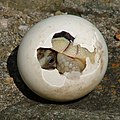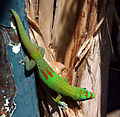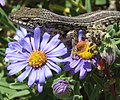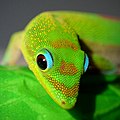User:The Transhumanist/Sandbox143
Introduction
Selected reptile type
An alligator, or colloquially gator, is a large reptile in the genus Alligator of the family Alligatoridae of the order Crocodilia. The two extant species are the American alligator (A. mississippiensis) and the Chinese alligator (A. sinensis). Additionally, several extinct species of alligator are known from fossil remains. Alligators first appeared during the late Eocene epoch about 37 million years ago.
The name "alligator" is likely an anglicized form of el lagarto, the Spanish term for "the lizard", which early Spanish explorers and settlers in Florida called the alligator. Early English spellings of the name included allagarta and alagarto. (Full article...)
Selected Crocodilia article
The Nile crocodile (Crocodylus niloticus) is a large crocodilian native to freshwater habitats in Africa, where it is present in 26 countries. It is widely distributed in sub-Saharan Africa, occurring mostly in the eastern, southern, and central regions of the continent, and lives in different types of aquatic environments such as lakes, rivers, swamps and marshlands. It occasionally inhabits deltas and brackish lakes and rarely also saltwater. Its range once stretched from the Nile Delta throughout the Nile River. Lake Turkana in Kenya has one of the largest undisturbed Nile crocodile populations.
Generally, the adult male Nile crocodile is between 3.5 and 5 m (11 ft 6 in and 16 ft 5 in) in length and weighs 225 to 750 kg (496 to 1,653 lb). However, specimens exceeding 6.1 m (20 ft) in length and 1,000 kg (2,200 lb) in weight have been recorded. It is the largest predator in Africa, and may be considered the second-largest extant reptile in the world, after the saltwater crocodile (Crocodylus porosus). Size is sexually dimorphic, with females usually about 30% smaller than males. The crocodile has thick, scaly, heavily armoured skin.
Nile crocodiles are opportunistic apex predators; a very aggressive crocodile, they are capable of taking almost any animal within their range. They are generalists, taking a variety of prey, with a diet consisting mostly of different species of fish, reptiles, birds, and mammals. As ambush predators, they can wait for hours, days, and even weeks for the suitable moment to attack. They are agile predators and wait for the opportunity for a prey item to come well within attack range. Even swift prey are not immune to attack. Like other crocodiles, Nile crocodiles have a powerful bite that is unique among all animals, and sharp, conical teeth that sink into flesh, allowing a grip that is almost impossible to loosen. They can apply high force for extended periods of time, a great advantage for holding down large prey underwater to drown. (Full article...)
Selected lizard article

The black rough-necked monitor (Varanus rudicollis) is a species of monitor lizard found in Southeast Asian countries of Thailand, Burma, and Malaysia. It is also found in Indonesia on Sumatra and islands of the Riau Archipelago It is sometimes known simply as the roughneck monitor. In Thailand is called h̄èā cĥāng (Thai: เห่าช้าง; "elephant bark").
The habitat of Varanus rudicollis is limited to primary and secondary rainforest and mangrove swamps. In the wild the black rough-necked monitor is very rarely seen, but whether this is because of its rarity or its very secretive behavior is uncertain. They are often kept successfully in captivity, but have a shy disposition.
This species is most closely related to its sister group, the water monitor species complex (e.g., the Asian water monitor) which are also in the subgenus Soterosaurus, having split from them 14 million years ago in the middle Miocene. (Full article...)
Selected turtle article

The Durango mud turtle (Kinosternon durangoense) is a species of mud turtle in the Kinosternidae family.
It is endemic to north-eastern Mexico. It is found in the states of Chihuahua, Coahuila, and Durango. (Full article...)
Picture slideshow
Selected snake article

The eastern green mamba (Dendroaspis angusticeps) is a highly venomous snake species of the mamba genus Dendroaspis native to the coastal regions of southern East Africa. Described by Scottish surgeon and zoologist Andrew Smith in 1849, it has a slender build with a bright green back and green-yellow ventral scales. Adult females average around 2 metres (6 ft 7 in) in length, and males are slightly smaller.
In spite of common urban legends and misconceptions labeling the eastern green mamba an aggressive, fast-moving “people-chaser”, it is in fact a shy and elusive species that remains hidden in the trees, and is rarely seen. This seclusion is usually attributed to its arboreal habitat and green colouration, which acts as effective camouflage in its natural environment. Even with its deadly venom, the green mamba has to protect itself from predators, including birds of prey and other snakes, such as cobras. It has been observed engaging in ambush predation, a trait seen among many Viperidae species, contrary to the active hunting style typical of other Elapidae snakes. It preys on arboreal and winged animals, such as birds and their chicks and eggs, bats, and arboreal rodents such as mice, rats, and gerbils.
Eastern green mamba venom consists of both neurotoxins and cardiotoxins. Symptoms of envenomation include swelling of the immediate bite-wound area, dizziness, vertigo and nausea, accompanied by dehydration, labored breathing and difficult swallowing. This eventually will develop into arrythmia and convulsions—all progressing to respiratory paralysis, which results in a fatal lack of oxygen to the brain. Bites that are severe or not immediately treated on-site can quickly prove deadly. (Full article...)
Categories
Topics
Associated Wikimedia
The following Wikimedia Foundation sister projects provide more on this subject:
-
Commons
Free media repository -
Wikibooks
Free textbooks and manuals -
Wikidata
Free knowledge base -
Wikinews
Free-content news -
Wikiquote
Collection of quotations -
Wikisource
Free-content library -
Wikiversity
Free learning tools -
Wiktionary
Dictionary and thesaurus































































